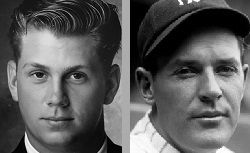
Supercalifragilisticexpialidocious:
The Making of 'Mary Poppins

The Babe (1992)
The third biopic of baseballer Babe Ruth contains many of the pitfalls that tripped up previous versions. It perpetuates some of the myths cloyingly depicted in The Babe Ruth Story and, like Babe Ruth, presents a lead character with few redeemable features, save for his ability to hit a baseball out of the park. Why then is The Babe the best incarnation thus far? The answer, quite simply, is John Goodman’s performance.
Abandoned by his father to St Mary’s Industrial School for Boys, Babe’s weight makes him the subject of ridicule until he displays his prowess with the baseball bat. After his ‘parole’, Babe joins the Boston Red Sox where his weight makes him the subject of ridicule until… well you get the gist. Now welcomed by his teammates and lauded by fans, Babe takes full advantage of all that his newfound wealth and fame afford him. The corrosive influence this has on the once lovable galoot increases exponentially when he joins The New York Yankees.
Like William Bendix before him, Goodman was in his forties when he first appears on screen as a teenage Babe. However, with the aid of good makeup and an ability to act childlike without appearing stupid, Goodman almost immediately engenders sympathy. This goodwill towards Babe survives his later boorish behaviour, not only because of the callbacks to St. Mary’s, but also by the innocence Goodman imbued his portrayal with during earlier scenes.
Regrettably the screenplay chooses to embellish myths rather than focus on key aspects of the Babe’s career. Apart from one very brief scene there is no depiction of his pitching skills, while Babe’s reputation for saving baseball after the 1919 Black Sox scandal is mentioned almost as an afterthought towards the film’s end. Apart from the frequent mock newsreels, which are poorly executed and unconvincing, the period detail is fine and the film’s raucous baseball scenes have an air of authenticity.

as 'Babe' Ruth

as Lou Gehrig

as Ty Cobb

as Bob Meusal
Babe Ruth was not a fat kid while he was at St. Mary's Industrial School for Boys.
Babe still kept in contact with his parents while at St. Mary’s. He frequently left St. Mary’s and went home. He even worked in his father’s saloon and later him father a nicer one after he began playing professional baseball.
Biopic implies that Babe and his first wife divorced. They did not, due to his Roman Catholic upbringing. They were separated when she died in a house fire. Babe married Claire a few months later.
Biopic depicts Babe visiting Johnny Sylvester in hospital during the 1921 World Series and promising to hit two home runs. In reality, Babe signed a baseball for Johnny promising to hit a home run during the 1926 World Series.
Ruth did not hit an infield pop so high that he had circled the bases for a home run before it landed. He did however reach third base twice on pops that landed just in the outfield behind the base paths.
Babe did not hit three home runs in his last game, but did so earlier in his last season. Nor did he have a designated runner.
Only mention of Babe’s film career is when he uses it as an excuse for being late to spring training.
